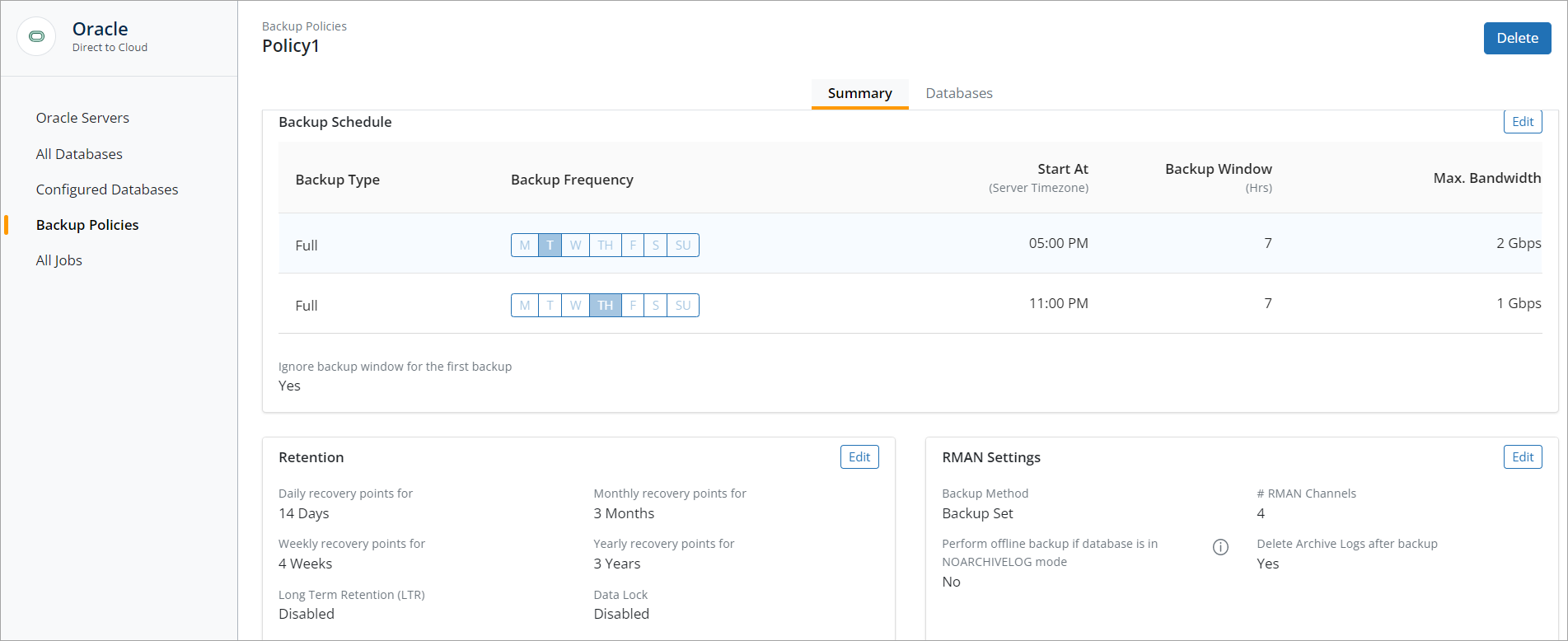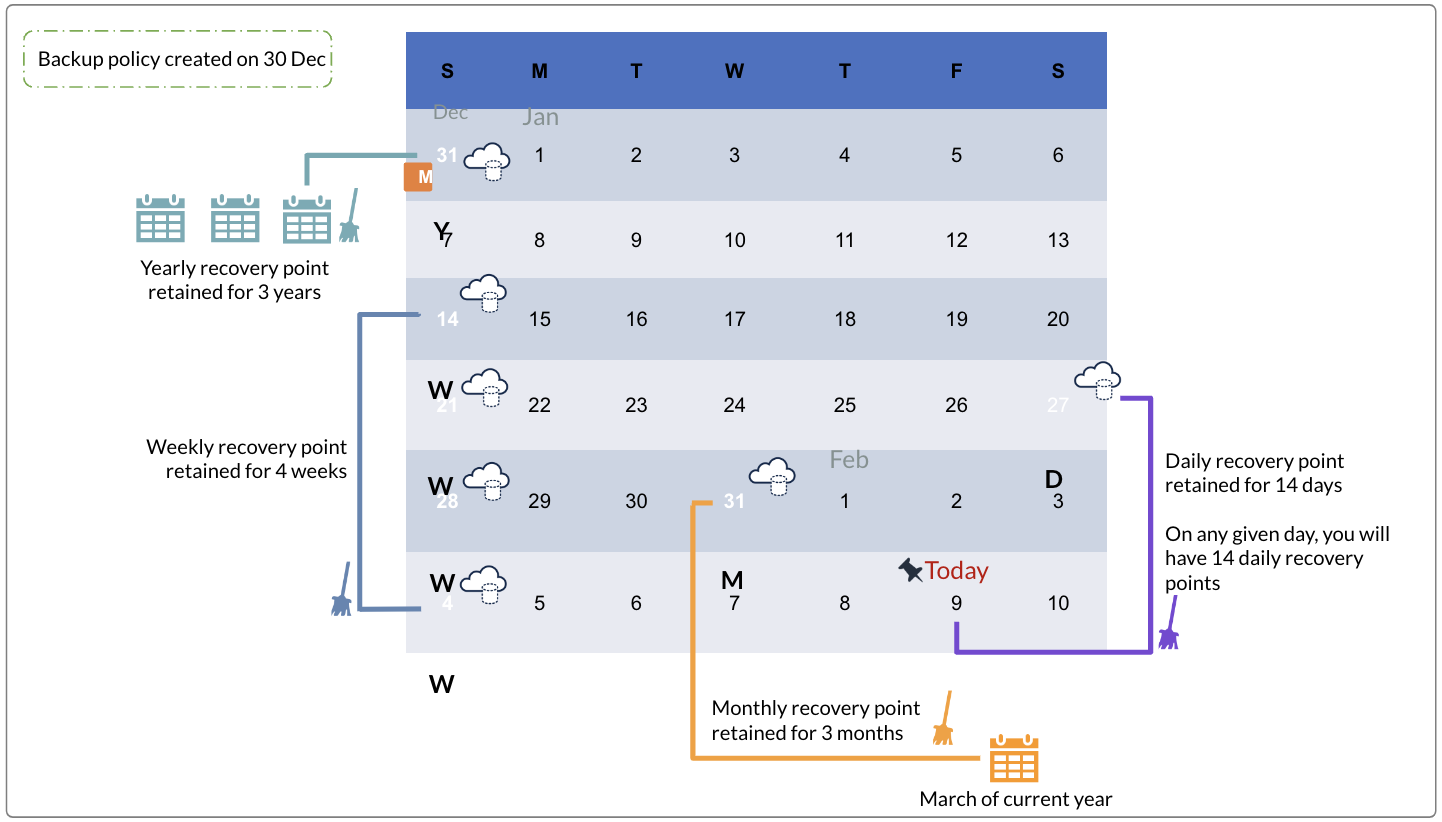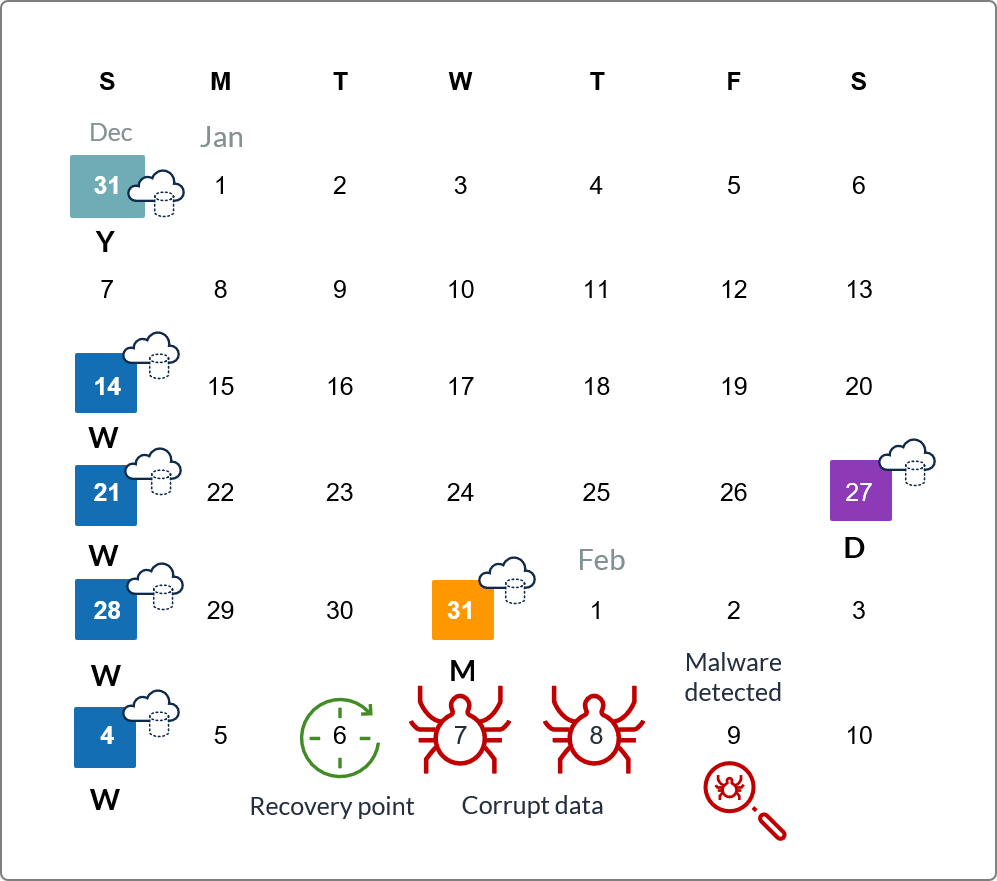Manage backup policy
 Business
Business  Enterprise
Enterprise  Elite
Elite
Overview of backup policy
Backup policies are rules that define a schedule, bandwidth for scheduled backups, and retention period for recovery points. In terms of Oracle Servers, you define the rules for full backups, incremental backups, and archive log backups.
A backup policy for an Oracle Server defines the following:
- When a backup job is triggered.
- The bandwidth available for the agent to execute a backup job.
- The backup frequency to back up archive logs.
- The period for which a recovery point is retained.
- Backup set is enabled or disabled for long term retention. To know more, see About long term retention.
You can create a backup policy and attach it to one or more databases. Druva backs up databases to the Druva Cloud based on the backup schedule defined in the backup policy.
Best practices for creating a backup policy
- Druva allows you to attach the same backup policy to different databases.
- You can assign only one backup policy to a database
- The backup policy defines the backup schedules for your Oracle servers. The schedules that you set depends on the volume and frequency of database change on your Oracle servers. The schedules also depend on the availability of bandwidth for data transmission to Druva Cloud. If you expect a large dataset during backups, you can schedule backups to run during off-peak hours, such as weekends or after a workday.
Notes:
- The backup schedule that you define in a backup policy depends on your organization's policies.
- You need to create at least one policy with FULL or Incremental schedule.
About retention
Create backup policy
Before creating a backup policy for Oracle databases, ensure that you read Overview of a backup policy. You can create a backup policy and attach it to one or more databases. Druva backs up databases to the Druva Cloud based on the backup schedule defined in the backup policy.
The following diagram depicts the steps and the attributes to be configured in the respective step, for creating the backup policy for an Oracle database.
- Step 1: Provide general information
- Step 2: Define backup schedule
- Step 3: Define retention period
- Step 4: Specify RMAN settings
Step 1: Provide general information
Step 2: Define a backup schedule
- In the Backup Schedule tab, provide the following details to define the backup schedule.
- Backup Type: The type of Oracle server backup, for example, Full, Incremental, or Archive Logs. For more information, see Backup methods.
- To define settings for the Full and Incremental backup type, provide the following details:
- Backup Frequency: The specific days of the week on which you want backups to occur.
- Start At: The time when you want backups to start. In the adjacent list, select AM or PM.
- Backup Window: The backup window for how long the backup should run. Type the number of hours.
Example: If you set Start at to 01:00 AM and you set the backup window to 6 hours, backups from your Oracle server start at 01:00 AM and stop at 07:00 AM, even if they do not complete. - Max. Bandwidth: The maximum bandwidth that the Oracle servers can consume while backing up data to the Druva Cloud.
Note: The maximum bandwidth that a backup job can consume is 2 Gbps (2048 Mbps).
- For a scheduled backup, the job will consume the assigned bandwidth.
- However, for manually triggered backup, the job will consume the available bandwidth on your network.
- To define settings for the Archive Logs backup type, provide the following details:
- Every: The interval at which Druva backs up the archived logs. Archived logs contain the changes made to the databases. In the adjacent list, select Hr or Min. The default value is 4 hours. However, Druva allows you to provide a minimum value of 5 minutes.
- Max. Bandwidth: The maximum bandwidth that the Oracle servers can consume while backing up data to the Druva Cloud.
Note: The maximum bandwidth that a backup job can consume is 2 Gbps (2048 Mbps).
- Click Add Schedule to add multiple schedules; repeat steps 1.a through 1.c to add as many schedules that you want to create.
- Click the delete icon next to the schedule to delete a schedule.
- Ignore backup window for the first backup: By default, the Ignore backup window for first backup option is enabled. When this option is enabled, Druva ignores the specified backup duration until the first backup job is complete. The first backup job is complete when the first recovery point is created. You can disable this option to enforce backup duration for the first backup job.
By default, Druva retries a job twice with a ten-minute interval between the two attempts. - Delete Archive Logs after backup: Select this check box to delete the archived logs on the Oracle server host after recovery points are created.
- Click Next.
Step 3: Define retention period
- In the Retain section, provide the following details to retain recovery points in the Druva Cloud:

- Daily Recovery points for: The duration for which you want to retain all recovery points.
- Weekly Recovery points for: The duration for which you want to retain weekly recovery points.
- Monthly Recovery points for: The duration for which you want to retain monthly recovery points.
- Yearly Recovery points for: The duration for which you want to retain yearly recovery points.
- Enable Long Term Retention: Toggle to enable or disable LTR for the backup policy. You can enable LTR only if the retention period is greater than or equal to one year. To know more about LTR, refer to About Long Term Retention. In the Keep recovery points in warm tier drop-down list, specify the duration in days to retain the recovery points in the warm tier. For example, 15, 30, 45, and 60 days. See Impact of changing the threshold on the existing recovery points.
- Enable Data Lock: Toggle to enable the Data Lock for the backup policy. For more information about Data Lock, refer to Data Lock for preventing malicious or accidental deletion of recovery points.
Note: Once you apply Data Lock to the backup policy, you cannot:
-
Disable Data Lock.
-
Delete the recovery points, backup sets, and backup policy.
-
Edit the retention period in the backup policy.
-
Associate another backup policy to the Data Lock-enabled backup set.
-
- Click Next.
Note: If you are registering the server under Default Organization, Druva provides a default backup policy with the following retention settings:
- Daily Recovery points for: 14 days
Weekly Recovery points for: 4 weeks
Monthly Recovery points for: 3 months
Yearly Recovery points for: 3 years
Step 4: Specify RMAN settings
Druva uses the Backup set method to back up Oracle databases.
In the RMAN Settings section, provide the following details:
- # RMAN Channels: Specify the number of channels to be established between RMAN and the databases to be backed up. The default value for the number of channels is set to ‘4’. Druva recommends you to specify a maximum of 32 RMAN channels. For more information about RMAN Channels, see About RMAN Channels.
Note: RMAN restricts you to allocate only one RMAN channel to back up and restore databases on the Oracle Standard Editions. The jobs are processed serially. However, you can allocate more than one RMAN channel to back up and restore databases on the Oracle Enterprise Edition and the jobs are processed in parallel.
- Perform an offline backup if database is in NOARCHIVELOG mode: Select this check box to perform an offline, full backup when a database is run in the NOARCHIVELOG mode. The database is shut down, started up in the mount mode, and backed up as a backup set. In this mode, the archival of redo logs is disabled and therefore, you cannot recover a database to a specific point-in-time.
- Delete Archive Logs after backup: Select this check box to delete the archived logs on the Oracle server host after recovery points are created.
- Click Finish to create the backup policy.
The Oracle backup policy is created successfully and assigned to the selected databases. To view the backup policy, on the menu bar, click Manage > Backup Policies. On the Manage Backup Policies, click the policy name and view the policy details.
Update backup policy
You can update an existing backup policy anytime as per your requirements. You can update details such as the policy name, backup schedule, retention settings, and RMAN settings.
Procedure
- Log in to the Management Console.
- Click Oracle > Direct to cloud from the Protect menu. Note that if the All Organizations menu is enabled, you have to first select an organization and then click Oracle > Direct to Cloud.
The Oracle Servers page opens. - In the left pane, click the Backup Policies tab.
The Backup Policies page appears with a list of existing backup policies. - Click the backup policy which needs to be updated. The Summary tab appears, by default.
To update backup policy summary
- In the Overview section, click Edit.
- On the Edit Overview dialog, provide a new name and description for the backup policy.
- Click Save to preserve the modifications made to this backup policy. The backup policy is saved with the modified settings.
To update backup schedule
- In the Backup Schedule section, click Edit.
- On the Edit Backup Policy Schedule page, update the backup schedule details as per your requirement: backup type, backup frequency, start at, backup window, maximum bandwidth, and the setting to ignore backup window during the first backup. For more information about these settings, see Backup schedule.
- Click Save to preserve the modifications made to this backup policy. The backup policy is saved with the modified settings.
Update retention settings
- In the Retention section, click Edit.
- On the Edit Retention page, update the duration for which Druva should retain the daily, weekly, monthly, and yearly recovery points. For more information about these settings, see Retention settings.
- Toggle Enable Long Term Retention to enable or disable LTR for the backup policy.
- Click Save to preserve the modifications made to this backup policy. The backup policy is saved with the modified settings.
Update RMAN settings
- In the RMAN Settings section, click Edit.
- On the Edit RMAN Settings page, update the number of channels to be established between RMAN and the databases based on the requirement, and the setting to perform an offline, full backup when a database is run in the NOARCHIVELOG mode and delete archive logs after the backup. For more details about these settings, see RMAN Settings.
- Click Save.
Duplicate Oracle backup policy
Instead of creating a new Oracle backup policy and defining each and every setting again, you can duplicate an existing backup policy, and update only the required parameters according to your requirements. When you duplicate a backup policy, the newly-created backup policy details are identical to the original backup policy.
Procedure
- Log in to the Management Console.
- Click Oracle > Direct to cloud from the Protect menu. Note that if the All Organizations menu is enabled, you have to first select an organization and then click Oracle > Direct to Cloud.
The Oracle Servers page opens. - In the left pane, click the Backup Policies tab.
The Backup Policies page appears with a list of existing backup policies. - Select the backup policy, which needs to be duplicated.
- Click Duplicate. The Duplicate Policy window appears.

- The Selected backup policy field displays the name of the backup policy selected for duplication.
- In the New backup policy name, type a name for this new backup policy.
- In the Description field, type a description for this backup policy.
- Click Duplicate.
- A backup policy is created with settings similar to the original backup policy and listed on the Backup Policies page.
- Click the name of the backup policy to view its details. You can edit the settings as per your requirement and save the policy. You can then assign the backup policy to a database, which defines the backup schedule.
Delete backup policy
If you are a cloud-derived or a group-derived administrator, you can delete backup policies that are not assigned to databases. Before you delete a backup policy associated with a database, ensure that you assign a new backup policy to the database.
Note: If the backup policy has Data Lock enabled, you cannot manually delete this backup policy.
Procedure
- Log in to the Management Console.
- Click Oracle > Direct to cloud from the Protect menu. Note that if the All Organizations menu is enabled, you have to first select an organization and then click Oracle > Direct to Cloud.
The Oracle Servers page opens. - In the left pane, click the Backup Policies tab.
On the Backup Policies page, click the backup policy which needs to be deleted. - On the backup policies details page, click Delete.

A dialog box appears asking for your confirmation. - Click Yes.




